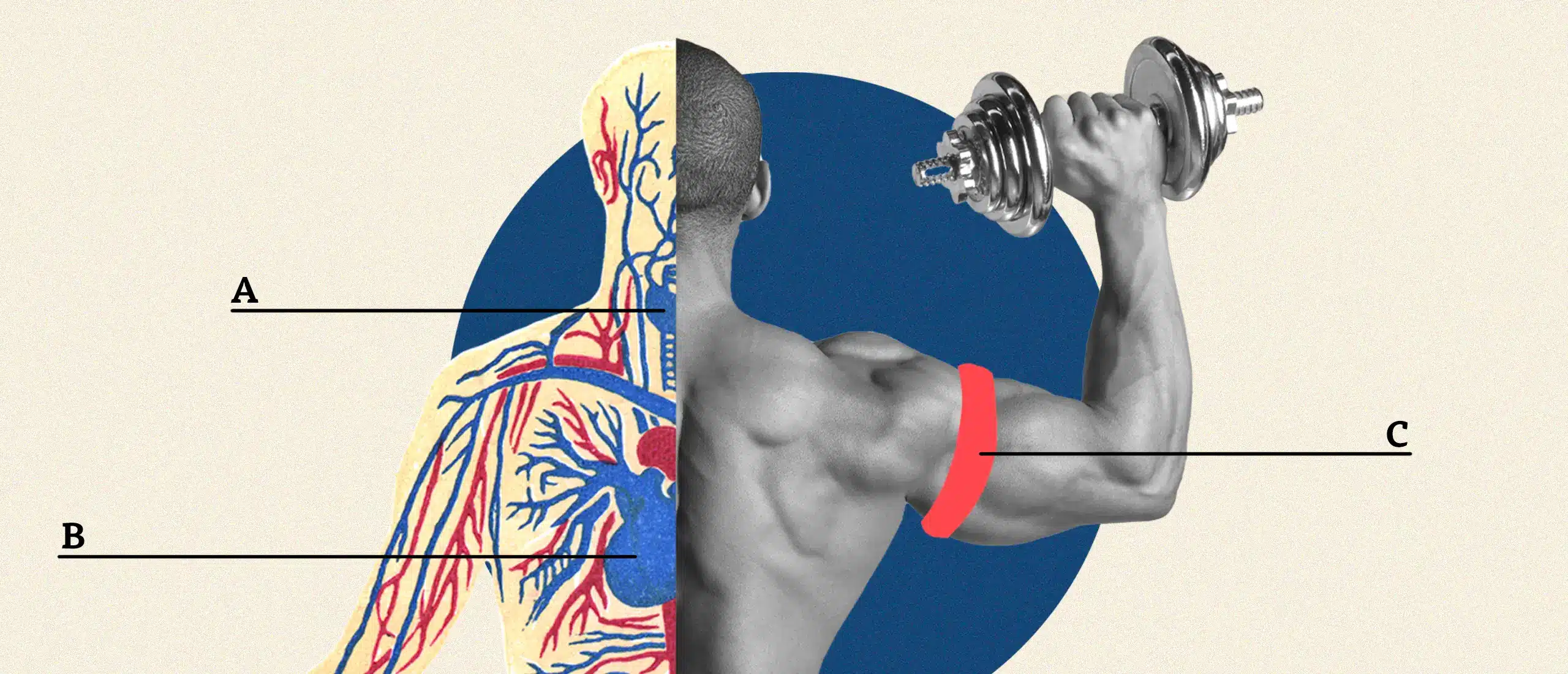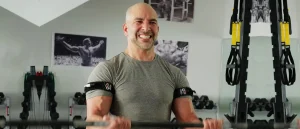Want More Gains? Blood Flow Restriction Training Might Be the Answer
As lovers of functional fitness, strength gains, and (let’s be honest) the all-hailed muscle pump, we don’t shy away from heavy lifting. But when muscle legend Layne Norton, Ph.D. and longevity physician Peter Attia, M.D. agree a training method can rack up comparable size and strength gains at a fraction of the work, we’re all ears.
Enter: blood flow restriction training.
Known for its ability to produce results similar to high-intensity training, blood flow restriction training merges low-intensity exercise with blood flow occlusion (or wearing a tourniquet around a muscle to restrict blood flow). The result? You can lift less weight and still build strength and muscle mass.
This makes BFR training a godsend for anyone who wants to increase strength or hypertrophy but doesn’t want to be lifting close to their max (or, at least not all the time). And since it allows you to build strength while working with lighter loads, it’s great for maintaining or regaining muscle after an injury. Here’s how it works.
What is Blood Flow Restriction Training?
Also known as occlusion training or the Kaatsu method, blood flow restriction (BFR) training is a technique performed while wearing a tourniquet (usually a cuff, strap, or elastic band) secured tightly around your arm or leg, to reduce—but not completely stop—blood flow at rest or during exercise.
When enough pressure is applied, BFR training can trick your body into thinking you’re working harder than you actually are. Meaning, you can lift significantly lighter loads and still see similar hypertrophy and strength gains as heavy resistance training while putting less overall stress on your muscles.
How Blood Flow Restriction Training Works
During blood flow restriction training, the tourniquet on the involved arm or leg decreases arterial blood flow (which carries oxygen into the muscle) and obstructs venous outflow (which usually clears lactate and other metabolic waste). Restricting regular blood flow temporarily creates a hypoxic (or low oxygen) environment in your muscle. This lack of oxygen and build-up of lactate accelerates fatigue—forcing your muscles to work harder and recruit higher-threshold motor units, which are typically reserved for lifting heavier loads.
Does Blood Flow Restriction Training Work?
According to the widespread use of BFR training amongst physical therapists, Olympic athletes, and everyday bodybuilders, yes. And the science checks out. Studies show blood flow restriction training can help reduce muscle atrophy, enhance muscle growth, increase strength adaptations, and improve aerobic capacity all in a low-load environment (1, 2, 3).
Benefits of Blood Flow Restriction Training
Considering giving BFR training a shot? Here’s what you can expect.
Increase muscle size
If you’re after hypertrophy, blood flow restriction delivers the goods. Exercise physiologist and blood flow restriction whiz Jeremy Loenneke Ph.D. explained to Attia on an episode of The Drive that BFR training is a more efficient way to increase muscle size.
Research agrees. A recent review suggests BFR training can significantly increase hypertrophy (2). One study suggests BFR trumps traditional resistance training for muscle growth (4). It found that athletes using BFR at 30 percent of their one-rep max (1RM) gained more strength and muscle thickness than athletes who trained traditionally at 80 percent of their 1RM.
Should you swap your resistance training sessions for blood flood restriction? “For muscle growth, it comes down to personal preference,” says Loenneke. If you don’t have the technical chops, desire, or focus to perform on a heavy-lifting day, try BFR training. You can expect a comparable amount of growth at lighter loads, decreasing your risk of injury.
Build strength
Studies suggest BFR training can improve hypertrophy and strength to a greater extent than low-load resistance training alone, and produces comparable gains to moderate to high-load resistance training (5).
That said, the real utility of BFR training is that you can do it with really low loads (like, 20 to 30 percent of your one-rep max). But lifting heavy is an essential component of building strength. “Lifting heavy is the best way to get better at lifting heavy,” explains Loenneke. So, even though you can get stronger lifting lighter loads with BFR, lifting heavy is still the gold standard for building strength.
Sure, you can throw a few extra plates on the bar, but Loenneke points out that since high-load training is already working near your max, combining it with blood flow restriction isn’t additive. Basically, if you want to lift heavy, just lift heavy.
Enhance endurance
Yep, blood flow restriction can increase your VO2 max (widely known as the best indicator of cardiovascular endurance and aerobic performance). When performed with BFR, low-intensity cycling resulted in significant improvements in VO2 max and time to exhaustion in healthy young men (6). Another study concluded that low to moderate aerobic exercise significantly increased VO2 max in healthy adults (3).
Aid recovery
Blood flow restriction training is often used in clinical settings like physical therapy offices or rehab clinics when a patient’s range of motion is limited or they aren’t able to safely lift heavy loads. “It appears that when you’re injured and working out with blood flow restriction you’re able to get more of that out of rehabilitation,” says Leonneke.
Though the practicality of BFR depends on the injury, there’s no arguing that lifting lighter loads is lower impact on your joints. One study found that BFR paired with low-intensity training can be used to help reduce pain and increase muscle strength after knee injuries (7). Another found it might be a viable means of increasing muscle strength and hypertrophy after ACL construction, with less pain (8).
Is Blood Flow Restriction Training Safe?
Generally, yes. “There’s always a risk with exercise; but, in my mind, the important question is not is there a risk, but when we add blood flow restriction does it increase the risk? It doesn’t appear to, at least in healthy individuals,” says Leonneke.
If you’re worried about how your muscle’s doing under that cuff, researchers haven’t identified any signs of additional muscle damage with blood flow restriction. “You will get sore, but when we look at the fiber it appears to be intact, it doesn’t result in structural damages,” says Leonneke.
Just like regular exercise, blood pressure after blood flow restriction is typically higher. However, blood pressure typically comes back down to baseline within five minutes, says Leonneke. A recent review also showed that the risk of blood clots with BFR training is extremely low (9). “That said, if you have a clinical ailment that might make you hypersensitive to it, you should talk to a doctor,” he says.
How to Add Blood Flow Restriction Training to Your Routine
Ready to get after it? Here’s exactly how Loenneke uses BFR training to boost muscle.
Use single-joint exercises
“You can do squats or deadlifts, but I prefer single-joint movements, especially if growth is the goal,” says Leonneke. He warns that while there’s evidence that blood flow restriction can help improve multi-joint movements like bench press, BFR training is hard. The question is will the discomfort change your mechanics, putting you at risk for injury?
If the answer is yes, stick to exercises you can complete safely and with proper form. For Attia, single-joint movements like leg extension, leg curl, leg press, biceps curl, and triceps extensions are favorites, as well as putting in time on the fan bike.
Use 40 to 90 percent pressure
Since you don’t want to completely occlude blood flow, pressure is important. Leonneke explains that in the lab they typically use a device called a Doppler to check blood pressure. “Before we have anybody do any exercise, we lie them down, slowly inflate whatever cuff we’re going to use until we don’t hear anymore flow, and then we take a percentage of that.”
According to Leonneke, the percentage will depend on your goal. “When all we care about is muscle adaptations, typically we use 40 percent,” he says. You can increase that pressure all the way up to around 80 to 90 percent and the adaptation will be pretty much the same, but the discomfort will be much different. In other words, 90 percent ain’t easy.
Don’t have a Doppler? If you’re in a clinical setting, you’ll want to get one; but for a healthy person in the gym, get SmartCuffs like Attia, or use your rep count as a gauge. If you can’t get through your work sets, loosen your cuffs. “If you’re in pain before even starting, they’re too tight,” he says.
The cuff size also matters. “The wider the cuff, the lower the pressure you need to reach occlusion,” says Leonneke.
Lift light loads
When you’re chasing muscle, the natural tendency is to reach for heavy weights. Drop your ego. The ideal range for blood flow restriction is around 20 to 30 percent of your one-rep max. If you can eke out a biceps curl with 90s, you’ll want to reach for around 15 to 25 pounds. If you’re sailing through your reps, then add more weight. Advanced lifters might creep up to 40 percent of their 1RM and beyond.
Aim for a high amount of reps
Leonneke typically aims for four sets, as many reps as possible, with 30 seconds of rest between sets. “If you’re using 20 to 30 percent [of your 1RM] you should be getting close to 30 reps on the first set. If you can’t, the load is probably too high or the wraps are too tight,” says Leonneke. On the following sets, don’t expect quite as much. He recommends aiming for 15 reps on the last three sets.
Play with pace
In the lab, Leonneke typically sticks to one second up, one second down. That doesn’t mean you can’t mess around with your rep pacing. For example, slowing down through the eccentric (lowering phase) can increase muscle time under tension and boost muscle growth.
“Muscle growth requires a muscle to be activated for a sufficient amount of time—there’s a lot of ways for that to occur. You can use really, really heavy weights repeatedly, low loads and high reps, or a very slow pace. They’re all doing similar things—you’re recruiting more fibers and signaling them to grow,” says Leonneke.
















